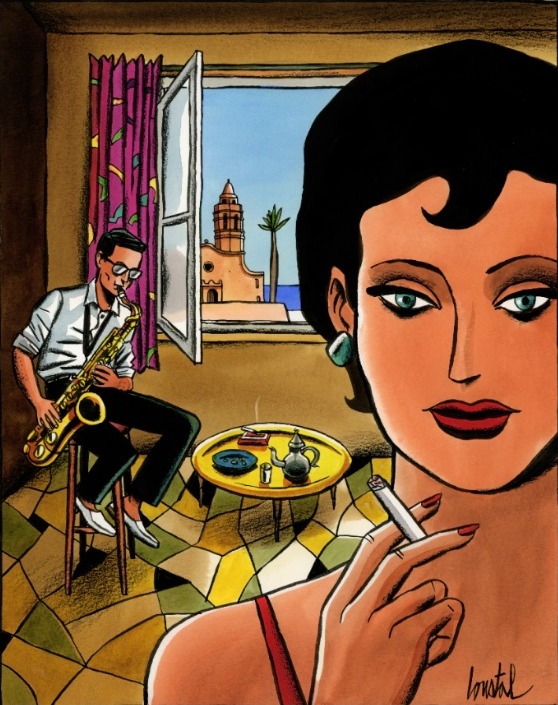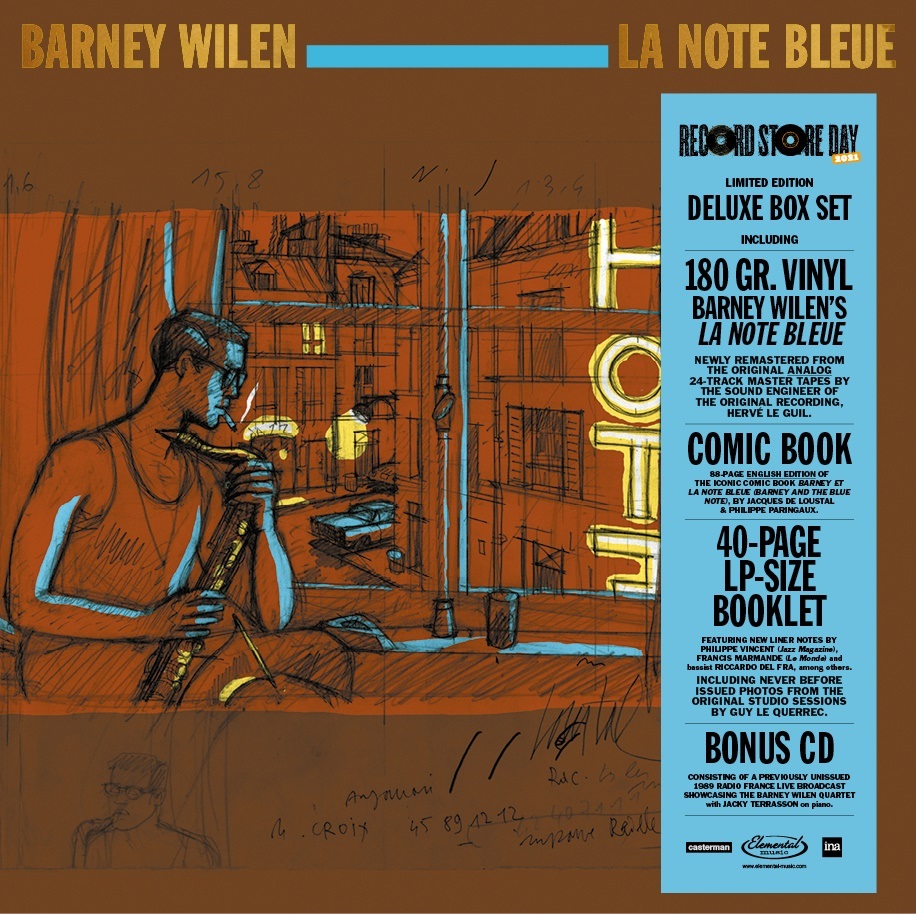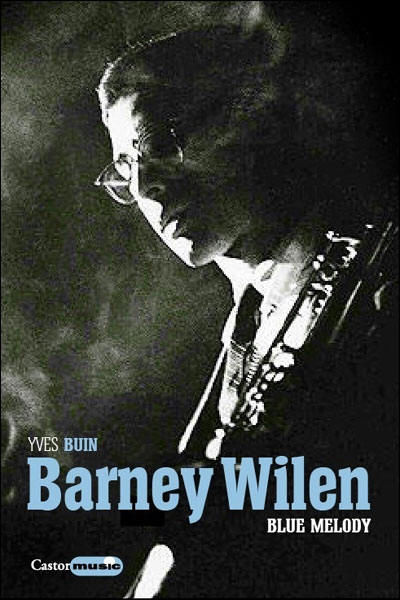

Barney Wilen “la note bleue” first official re-release after 34 years.!
Barney Wilen “LA NOTE BLEUE” first official re-release after 34 years.! (Limited Edition Deluxe Box Set) – RSD 2021 - Release Date: 6/12/2021 (june 12th 2021) (Record Store Day 2021)
On video From left to right: Eric Mills, Patrick Wilen, Satomi Wilen & Jordi Soley (Elemental Music).
Label: Elemental Music, Barcelona, produced by: Jordi Soley, associate producer: Patrick Wilen, art director: Josep Basora, Barcelona, release date: record store day (june 12th 2021) limited 2000 edition de-luxe box set, including:
* 180-gram virgin vinyl edition of the historical Barney Wilen LP LA NOTE BLEUE, newly remastered from the original 24-tracks master tapes by the former sound engineer hervé le guil. the original album was awarded the grand prix jazz de l'académie charles cros as best french jazz album of the year 1987.
* Complete 88-page English edition of the iconic Jacques De Loustal & Philippe Paringaux comic story: Barney and the Blue Note (Translation of the French version Barney et la Note Bleue.)
* 24 page LP-size booklet featuring new liner notes by Philippe Vincent (jazz magazine), Francis Marmande (Le Monde) and bassist Riccardo Del Fra, also including never issued photos from the original studio session by Guy Le Querrec and other unpublished archives.
* Bonus cd consisting of a unissued live broadcast by Radio France presented by Claude Carrière: the Barney Wilen quartet recorded in 1989 at the Parisian Jazz Club „Le Petit Opportun“, issued here thanks to the collaboration of the INA (Institut National de l’Audiovisuel). the cd includes new versions of several LA NOTE BLEUE tunes and features Jacky Terrasson (piano), Gilles Naturel (double-bass) and Peter Gritz (drums).
Special thanks to all the musicians involved in this project: Alain Jean-Marie, Philippe Petit, Riccardo Del Fra, Sangoma Everett, Jacky Terrasson, Gilles Naturel & Peter Gritz. and last but not least: Philippe Paringaux, Jacques De Loustal & Philippe Vincent.
More information: https://www.instagram.com/barney.wilen/ or https://www.barneywilen.com

Limited edition, numbered, 180g vinyl of the celebrated Barney Wilen LP, La Note Bleue. Newly re-mastered from the original 24-track master tapes. Also includes; complete 88 page English edition of the iconic comic strip Barney Et La Note Bleue, 40-page LP-size booklet featuring new liner notes and never before seen photos, plus a bonus CD consisting of a previously unissued radio France live broadcast recorded in 1989 at The Parisian jazz club Le Petit Opportun.
Format: Vinyl
Label: Anagram Music
Rel. Date: 06/12/2021
UPC: 8435395502983
Vente: £84.99 /100 euro
https://criminalatl.com/UPC/8435395502983
https://www.roughtrade.com/gb/barney-wilen/la-note-bleue
SIDE A:
1. BÉSAME MUCHO
2. NO PROBLEM (L’HABIT DE LUMIÈRE) [THE MATADOR’S SUIT]
3. PAULINE
4. ‘ROUND MIDNIGHT [ROUND ABOUT MIDNIGHT]
5. LES JOURS HEUREUX [HAPPY DAYS]
6. MR MARTIN (VOLEUR D’AMOUR) [THIEF OF LOVE]
7. UN BAISER ROUGE [A BLOOD RED KISS]
8. PORTRAIT DE L’ARTISTE AVEC SAXOPHONE [PORTRAIT OF THE ARTIST WITH SAXOPHONE]
SIDE B:
1. WHISPER NOT
2. TRISTE AGAIN [BACK TO SADNESS]
3. HARLEM NOCTURNE
4. BÉSAME MUCHO (REPRISE) [Solo]
5. GOODBYE
6. ALL BLUES *
* Bonus track from the same sessions, but not included on the original LP
LA NOTE BLEUE by the new BARNEY WILEN QUARTET LIVE AT LE PETIT OPPORTUN 1989 - CD
1. NO PROBLEM
2. ALL BLUES
3. BÉSAME MUCHO
4. COMMENTARY BY CLAUDE CARRIÈRE
5. ‘ROUND MIDNIGHT
6. GOODBY
Bernard "Barney" Jean Wilen (4 March 1937 – 25 May 1996) was a French tenor and soprano saxophonist and jazz composer.
Wilen was born in Nice, France; his father was an American dentist turned inventor, and his mother was French. He began performing in clubs in Nice after being encouraged by Blaise Cendrars who was a friend of his mother. His career was boosted in 1957, when he worked with Miles Davis on the soundtrack for the Louis Malle film Ascenseur pour l'Échafaud (Elevator to the Gallows). In 1959, Wilen wrote his two soundtracks Un Témoin Dans la Ville and Jazz sur scène with Kenny Clarke. He wrote a soundtrack for Roger Vadim's film Les Liaisons Dangereuses two years later, working with Thelonious Monk. Wilen returned to composing for French films in the 1980s and 1990s. In the mid-to-late 1960s, he became interested in rock, and recorded an album dedicated to Timothy Leary. Wilen toured in Japan for the first time in 1990.[4] He also worked with punk rockers before returning to jazz in the 1990s. Wilen played with modern jazz musicians until his death in 1996. He died of cancer in Paris at the age of 59.
In 1987, French comic book artist Jacques de Loustal and author Philippe Paringaux paid homage to Wilen in their "bande dessinée" Barney et la note bleue ("Barney and the blue note").
https://en.wikipedia.org/wiki/Barney_Wilen
French-American saxophonist Barney Wilen passed away for the second time last week. He was 59 and was suffering from cancer. Nine years ago, in 1987, he also died once - of a combination of heroin and an overdose of unhappy love - but he had successfully rebelled against it.
At the time, French comics authors Loustal and Paringaux described in monthly episodes the tragic fate of a brilliant white bebop saxophonist named Barney Wilen, whose appearance and career resembled those of the real thing like two drops of water.
In real life and in the comic, he was born in 1937 to an American father and a French mother. He was not yet twenty when he made his debut as an alto saxophonist in Paris shortly after the Second World War, but his style stood out and he played with the greats of his time: Thelonious Monk, Dizzy Gillespie, Bud Powell, Kenny Dorham, Miles Davis and Art Blakey. His music - a subtle mixture of precise and casual - can still be heard in famous film noirs such as Les liaisons dangereuses and Aseenseurpour l'échafaud (by Louis Malle).
After that, the comic strip Barney and the real parted ways. The cartoon character goes awry and dies. The real one, as he said, had fled the "monoculture of bebop", traveled to Africa. to listen to drums and the wind and made a few records that would later be called free jazz - far beyond the view of the average listener. Until the mid-eighties he devoted himself to producing other artists and organizing jazz concerts in the south of France.
There he accidentally read in A Suivre about his own death and protested. Loustal and Paringaux admitted that they should have checked that he had actually died, but also said that this was a good opportunity for a comeback. When the comic strip Barney et la Note Bleue - and the Dutch weakly translated as Besame Mucho - appeared in book form, a CD of the new Barney Wilen was simultaneously released, the first soundtrack to a comic strip about which Le Monde wrote that it was necessary for the popularity of jazz would have been more important than the movie 'Round Midnight, starring Dexter Gordon.
His first death did him no harm. He formed a new quintet that bore his name, his old records were re-released, and he toured the US, Canada and Japan. Jazz fundamentalists thought his reincarnation played "slick" - for example on a CD with French orchestra arranged by him. chansons (French ballads). Self added that "unless you're the Rolling Stones you can't keep playing everything the same way year after year." Loustal and Paringaux certainly saw his real end well: he did everything he could to play the tragic saxophone hero. He drank like a sponge and smoked like a heretic. Prior to an interview in 1987, he appeared in the door of his hotel room dressed in a hat and towel, while a bath overflowed in the background.


ARDONCEAU, Pierre-Henri, BOUJUT, Michel, « Variations sur la note bleue - Une rencontre passionnante du jazz et de la bande dessinée, avec musique », Jazz Magazine, 357, janvier 1987, p. 17-25.
BERENDT, Joachim, texte traduit de l’allemand vers l’anglais par KUHRT, Peter, livret du disque de WILEN, Barney, Dear Prof. Leary, MPS 15191ST, 1968.
BERGER, Daniel, « Disques - Barney Wilen, Le nouveau jazz », Jazz Hot, 230, avril 1967, p.7.
BUIN, Yves, livret du disque de TUSQUES, François, Le nouveau jazz, Mouloudji EM-133517, 1967.
CARLES, Philippe, « La mission Barney », Jazz Magazine, 199, avril 1972, p. 12-18.
CARLES, Philippe, COMOLLI, Jean-Louis, « Entretien avec Barney Wilen. Portrait d'un fantôme », Jazz Magazine, no 127 février 1966, p. 29-34.
MOULIS, Raymond, « Des disques et des couleurs - Barney », Jazz Magazine, 67, février 1961, p.37.
LAPIJOVER, Pierre, « Jazzman et français, Barney Wilen », Jazz Hot, 355, novembre 1978, p. 30-35.
M. LeBris: “Barney Wilen: ma direction c’est le rock,” Jazz Hot, no.245 (1968),
LUCAS, Emilie, « Le mythe Barney, le style Wilen », Jazz Magazine, no 412, février 1992, p.28-30.
MASSON, Jean-Robert, « Barney », Jazz Magazine, 67, février 1961, p. 18-21.
MASSON, Jean-Robert, « Le destin romantique de Barney Wilen », Jazz Magazine, 461, été 1996, p. 19-22.
PECK, Nat, « Critiques croisées - Jazz sur Seine », Jazz Hot, 144, avril 1959, p. 23-24.
RENAUD, Henri, propos recueillis par DRUSSANT, Didier, livret du disque de GOURLEY, Jimmy, WILEN, Barney, Double action, Elabeth 621032, 1987.
RENAUD, Jacques, « Disques - Barney Wilen, Auto Jazz », Jazz Hot, 244, octobre 1968, p. 40.
ROMANO, Marcel, « Barney Wilen », Jazz Hot, 122, juin 1957, p. 16, 17.
SOKOLOWSKI, Nicolas, « On achève bien les saxos », Jazz Hot, 446, novembre 1987, p. 35- 37.
WILEN, Barney, « Sonny Rollins apprécié par Barney Wilen », Jazz Hot, 117, janvier 1957, p. 27.
ZEKRI, Camel, « What’s old but new ? », Les allumés du jazz, 7, 4è trimestre 2002, p. 15.
Livre: Vincent COTRO, Chants libres - Le free-jazz en France, 1960-1975, Paris, Éditions Outre Mesure, coll. « Contrepoint », 1999.
288 p., Collection : Contrepoints - ISBN 2907891197
Book: After Django: Making Jazz in Postwar France, Tom Perchard
2015
Series: Jazz Perspectives
Paperback: 308 pages
Publisher: University of Michigan Press (January 12, 2015)
Language: English
ISBN-10: 047205242X
ISBN-13: 978-0472052424
Barney Barney Phantoms of Freedom chapter 5 p. 144 - 154?
www.barneywilen.com (Facebook /metaverse)
https://www.instagram.com/barney.wilen/

Yves Buin Author / Auteur: Yves Buin
Titre: Barney Wilen, Blue melody Barney Wilen, Blue melody (French Edition)
Date de parution: 05/05/2011
Paperback: 126 pages
Publisher / Editeur: Le Castor Astral
Language / Langue: French / Francais
ISBN-10: 2859208623
ISBN-13: 978-2859208622
Bernard Jean Wilen, dit Barney Wilen (1937-1996), né d'une mère française et d'un père américain, est considéré comme " le seul ténor européen susceptible de concurrencer les maîtres américains ". Sur les encouragements de Blaise Cendrars, il commence à se produire dans les clubs de Nice, avant de monter à Paris à l'âge de seize ans. Quatre ans plus tard, musicien prodige, il participe aux mythiques sessions d'enregistrement pour le film de Louis Malle, Ascenseur pour l'échafaud, orchestrées par Miles Davis. Bamey Wilen se produit à Saint-Germain-des-Prés avec les vedettes du be-bop comme Dizzy Gillespie, Art Blakey et Bud Powell, à Nice avec Stan Getz et Curtis Fuller, et enregistre avec des artistes comme Martial Solal, Milt Jackson et Flavio Ambrosetti. Après s'être retiré en pleine gloire, il réapparaît en précurseur du free jazz européen et s'ouvre à l'influence de la pop music, définissant ainsi les principes du free jazz rock. En 1987 paraît La Note bleue (Grand Prix de l'Académie Charles Cros), disque à succès sorti en même temps qu'une bande dessinée de Loustal et Paringaux inspirée de sa vie. Yves Buin signe ici la toute première biographie consacrée à Barney Wilen.
Biographie de l'auteur
Yves Buin est notamment l'auteur de Thelonious Monk (Le Castor Astral) et " Free at Last in Treize morts d'Albert Ayler (Gallimard). Romancier et essayiste, nombre de ses titres de l'ivres font directement référence au jazz. Spécialiste de jack Kerouac il a établi et présenté l'édition Sur la route et autres romans (Gallimard) et publié les biographies Jack Kerouac et Céline (Gallimard).